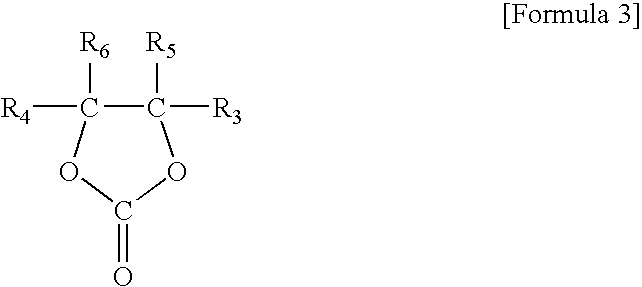Non-aqueous electrolyte composition for batteries
a lithium secondary cell, non-aqueous electrolyte technology, applied in the direction of non-aqueous electrolyte cells, primary cells, electrochemical generators, etc., can solve the problems of difficult selection of appropriate solvents and their ratios, high cost of vinylene carbonate and butylene carbonate, and economic unfavorable, etc., to improve the cycle life, low temperature performance, initial capacitance and cycle life properties of lithium secondary cells
- Summary
- Abstract
- Description
- Claims
- Application Information
AI Technical Summary
Problems solved by technology
Method used
Image
Examples
examples 1 through 5
In these examples, one compound was selected from each of the solvent groups respectively represented by the general formulas 1 to 3 and the selected solvent compounds were mixed at different ratios within the effective range of the invention.
In Example 1, ethylene carbonate (EC), dimethyl carbonate (DMC) and fluorobenzene (FB) were mixed at a volume ratio of 1: l: 1 while LiPF6 was dissolved as a solute. The electrolyte thus obtained was used to prepared a 18650 cylindrical cell, after which an examination was made of the discharge / charge capacity ratio (%) after a first charge / discharge cycle, the discharge / nominal capacity ratio (%) at −20° C., and the discharge / nominal capacity ratio (%) after 150 cycles to evaluate the life performance of the cell. The results are given in Table 1, below. In the cell, carbon black was used as an active material for the anode, polyvinylidenefluoride (PVDF) as a binder, LiCoO2 as an active material for the cathode, and acetylene black as a curren...
examples 6 through 10
In these examples, mixtures of the compounds selected from the general formulas 1 to 3, were used as solvents for the electrolyte with the solvent component of the general formula 1 being changed according to examples.
In Example 6, a mixture of 3:3:1:1 ethylene carbonate (EC): diemthyl carbonate (DMC): diethyl carbonate (DEC): fluorobenzene (FB) was used as a solvent to prepare a cell. An examination was made of the discharge / charge capacity ratio (%) after storage at a high temperature (60° C.), the discharge / nominal capacity ratio (%) at −20 C. and the discharge / nominal capacity ratio (%) after 300 cycles to evaluate the life performance of the cell. The results are given in Table 2, below.
In Examples 7 through 10, the same procedure as in Example 6 was repeated except that the solvent components were used according to the instruction of Table 2, below. The cells thus prepared were measured for the above properties and the results are given in Table 2.
examples 11 through 15
In these examples, two compounds of the general formula 3, and one compound of each of the general formulas 1 and 2, were mixed at different ratios within the volume range of the present invention and evaluated for their influence on the properties of cells, especially standard capacity against nominal capacity. Ethylene carbonate (EC), dimethyl carbonate (DMC), propylene carbonate (PC), and fluorobenzene (FB) were mixed at volume ratios according to the instructions of Table 3, below to prepare cells. An examination was made of the standard capacity / nominal capacity ratio (%), the discharge / nominal capacity ratio (%) at −20° C., and the discharge / nominal capacity ratio (%) after 300 cycles to evaluate the life performance of the cell. The results are given in Table 3, below.
PUM
| Property | Measurement | Unit |
|---|---|---|
| concentration | aaaaa | aaaaa |
| volume ratio | aaaaa | aaaaa |
| temperature | aaaaa | aaaaa |
Abstract
Description
Claims
Application Information
 Login to View More
Login to View More - R&D
- Intellectual Property
- Life Sciences
- Materials
- Tech Scout
- Unparalleled Data Quality
- Higher Quality Content
- 60% Fewer Hallucinations
Browse by: Latest US Patents, China's latest patents, Technical Efficacy Thesaurus, Application Domain, Technology Topic, Popular Technical Reports.
© 2025 PatSnap. All rights reserved.Legal|Privacy policy|Modern Slavery Act Transparency Statement|Sitemap|About US| Contact US: help@patsnap.com



